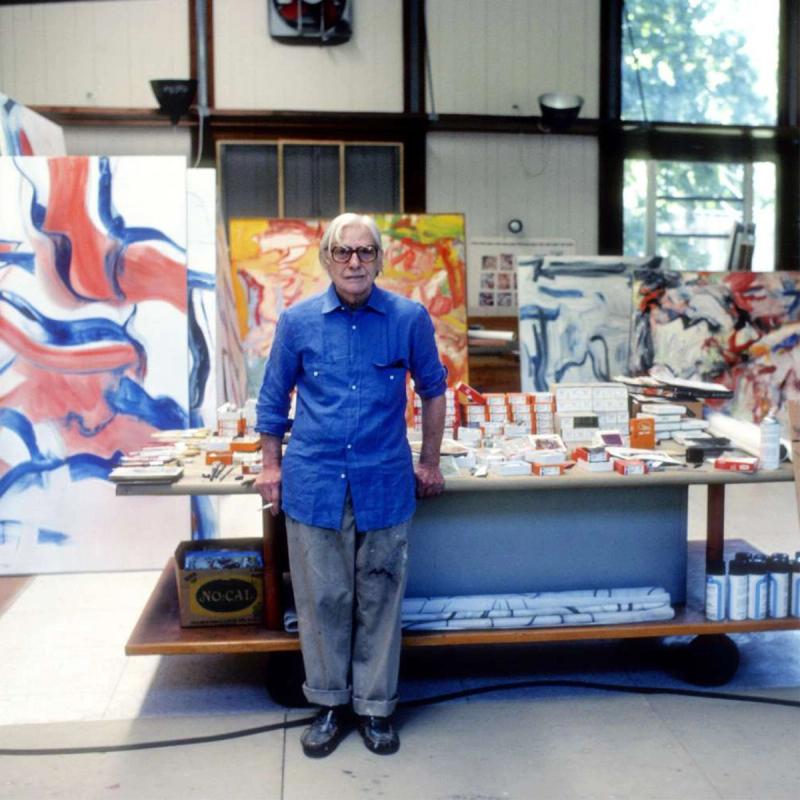Willem de Kooning
“For me, only one point comes into my field of vision. This narrow, biased point gets very clear sometimes. I didn’t invent it. It was already here. Everything that passes me I can see only a little of, but I am always looking. And I see an awful lot sometimes.”
A protagonist of the New York School, Willem de Kooning (1904–1997) was a progenitor of Abstract Expressionist painting, though his work far exceeded the terms of that movement. Over nearly seven decades, he maintained a striking consistency of aesthetic concerns while moving between abstraction and figuration. Characterized by supple, agitated, carnal, and immediate pictorial events, his work emerged from diverse and virtuosic methods of paint application. His accumulations of gesture resulted in ecstatic and mercurial suggestions of imagery.
Born in Rotterdam, the Netherlands, to a working-class family, de Kooning studied at the Rotterdam Academy of Fine Arts and Techniques (renamed in his honor in 1998 as the Willem de Kooning Academie). In 1927, he settled in New York City, where he soon established himself as a commercial artist and befriended such artists as Arshile Gorky and Stuart Davis. In 1936, he worked in the mural division of the Works Project Administration (WPA) and began painting full time. By the late 1940s, de Kooning and his New York peers, including Franz Kline, Robert Motherwell, Jackson Pollock, and Mark Rothko, were renowned for their abstract paintings that focused on improvisation, process, and spontaneity. Their work marked the first significant avant-garde art movement to develop in the United States, known variously as “Action Painting,” “Abstract Expressionism,” and the “New York School.” De Kooning’s first solo exhibition, featuring black-and-white abstractions, was mounted at Charles Egan Gallery, New York in 1948, and in 1951 he received the Logan Medal and Purchase Prize from the Art Institute of Chicago for his monumental abstraction, Excavation (1950). He garnered fervent support from preeminent critics Clement Greenberg and Harold Rosenberg, but lost Greenberg’s favor when he returned to figuration with his controversial 1953 exhibition of “Women” paintings at Sidney Janis Gallery, New York. By the late 1950s, he had turned to muscular abstractions based on landscapes, referred to as “Urban,” “Parkway,” and “Pastoral.” In 1963, de Kooning moved to Springs, in East Hampton, Long Island, into a home and studio he designed himself. His new environment was mirrored in his work, as his palette and figures became softer and looser. In 1969, in Rome, he completed his first sculptures, and the following decade was marked by material experimentation, including series of lithographs reflecting the influence of ink drawing and calligraphy encountered during his travels to Japan in 1970. De Kooning continued to explore the possibilities of painting until his last work, painted in 1991.
De Kooning’s many honors include the Presidential Medal of Freedom (1964) and the Andrew W. Mellon Prize (1979). He participated in the Venice Biennale (1950, 1954, 1956) and Documenta, Kassel (1959, 1977), among thousands of exhibitions. In 1968, his first international touring retrospective opened at the Stedelijk Museum, Amsterdam, and traveled to the Tate Gallery, London; Museum of Modern Art, New York; Art Institute of Chicago; and Los Angeles County Museum of Art. Retrospectives dedicated to his work have also been organized by such museums as the School of the Museum of Fine Arts, Boston (1953); Smith College Museum of Art, Northampton, Massachusetts (1965); Museum of Modern Art, New York (1997, 2011); Whitney Museum of American Art, New York (1983); and National Gallery of Art, Washington, DC (1994) and traveled to numerous other venues.
Exhibitions
- Willem de Kooning / Zao Wou-Ki
- Lévy Gorvy, New York
January 19 - March 11, 2017 With Willem de Kooning | Zao Wou-Ki, Lévy Gorvy presented the first exhibition to pair the abstract landscapes of Chinese-French master Zao Wou-Ki (1920–2013) and the works of Dutch-born American titan Willem de Kooning (1904–1997). With the full support of the Willem de Kooning Foundation and the Fondation Zao Wou-Ki, this exhibition inaugurated the partnership of Dominique Lévy and Brett Gorvy. It was the first presentation in their gallery’s expanded space at 909 Madison Avenue.
Although contemporaries, the two postwar painters never met. The exhibition at Lévy Gorvy...
Read More
